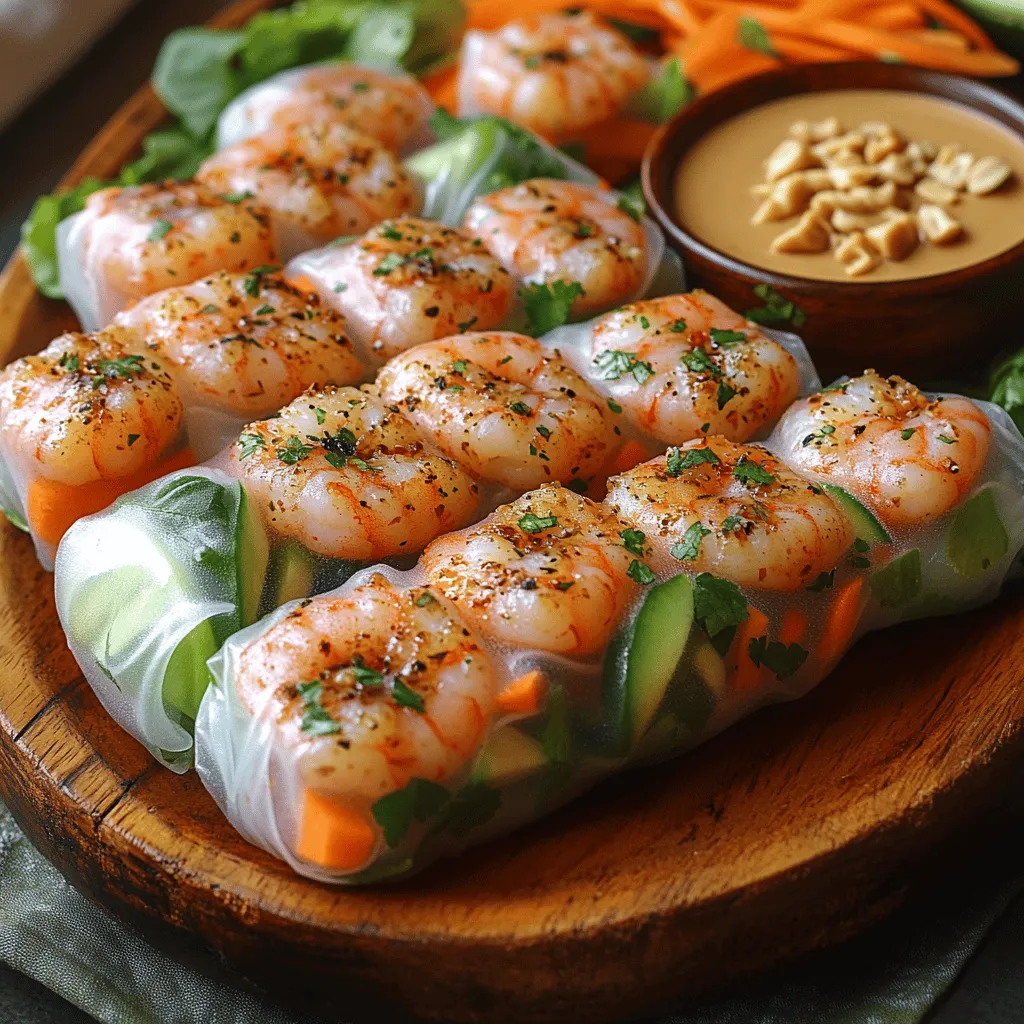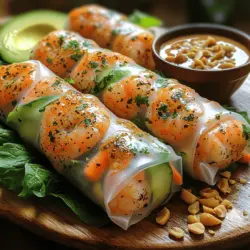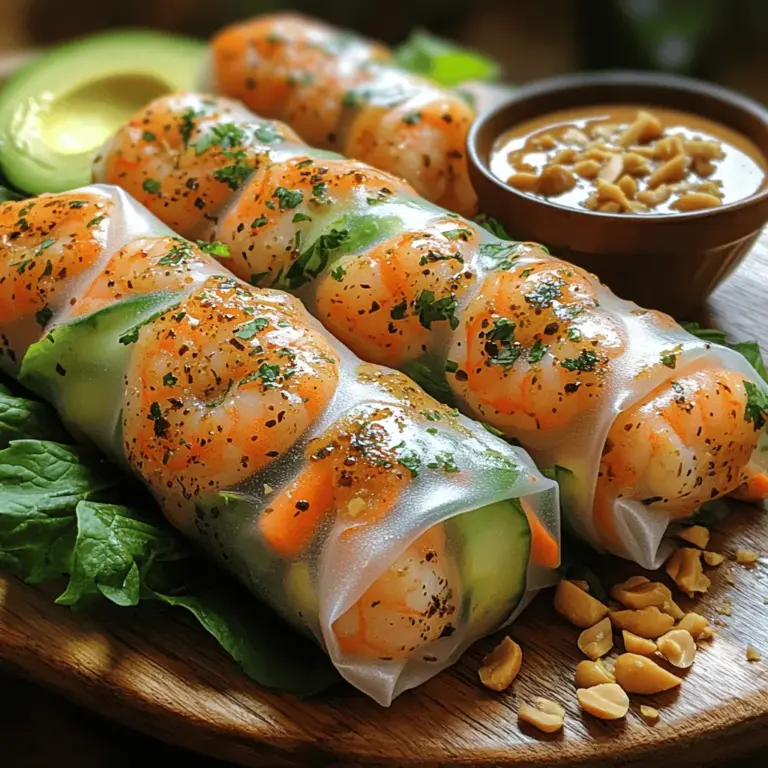Introduction
Spring rolls are a vibrant and versatile culinary delight beloved across various cultures, particularly in Asian cuisine. From the crispy fried versions of Chinese spring rolls to the delicate, fresh rolls found in Vietnamese cuisine, these delightful bundles have captured the hearts of food enthusiasts around the globe. Their ability to combine a variety of fresh ingredients into a convenient, hand-held meal makes them a popular choice for appetizers, snacks, or even light meals.
Today, we are excited to introduce a fresh and zesty shrimp spring rolls recipe. These rolls are not just visually stunning but are also packed with flavors and textures that dance on your palate. Made with succulent shrimp, crisp vegetables, and fragrant herbs, these spring rolls embody a perfect balance of freshness and zest, making them an ideal dish for any occasion—from casual gatherings to elegant dinner parties. The best part? They are incredibly easy to prepare, allowing you to impress your guests without spending hours in the kitchen.
In this article, we will delve into the cultural significance of spring rolls, what makes our shrimp spring rolls a must-try, and provide you with a detailed overview of the ingredients to ensure you achieve the best results. Let’s embark on this culinary journey and discover how to create the perfect fresh and zesty shrimp spring rolls!
Understanding Spring Rolls
Spring rolls are a traditional dish that dates back centuries, with roots in various Asian cultures. In Vietnam, they are known as “gỏi cuốn,” while in China, the term “spring rolls” often refers to a fried pastry filled with vegetables or meat. Each region has its unique take on this dish, but at their core, spring rolls represent a celebration of fresh ingredients and the art of rolling them into a delightful package.
The cultural significance of spring rolls is profound, often symbolizing prosperity and good fortune in many Asian cultures. They are typically enjoyed during festive occasions like Lunar New Year, where the act of rolling the ingredients together mirrors the hope of wrapping up good luck for the coming year. These rolls also serve as a versatile canvas for creativity, allowing cooks to adapt them to local ingredients and personal preferences.
While the traditional components of spring rolls can vary widely, they generally consist of a wrapper and a filling. The wrapper can be made from rice flour, wheat flour, or even bean starch, depending on the region and style. The filling usually includes a combination of proteins, vegetables, and herbs, creating a delightful medley of flavors and textures.
Ingredients Overview
For our fresh and zesty shrimp spring rolls, we will be using a selection of high-quality ingredients that not only enhance the flavor but also contribute to the dish’s nutritional value. Here’s a detailed look at each of the main ingredients you will need:
Large Shrimp
Shrimp is the star of this dish, providing a rich source of protein and essential nutrients. When selecting shrimp, look for large, preferably wild-caught shrimp, as they tend to have a better flavor and texture compared to farmed varieties. Shrimp are low in calories but high in protein, making them an excellent choice for a healthy meal. Additionally, they are packed with vitamins and minerals such as selenium, vitamin B12, and iodine.
Rice Paper Wrappers
Rice paper wrappers are a crucial component of spring rolls, serving as the delicate envelope that holds all the delicious fillings. When choosing rice paper, look for high-quality wrappers that are pliable and easy to work with. They come in various sizes, but the standard diameter is around 8-10 inches. For the best results, soak the wrappers in warm water just until they become pliable, making them easier to roll without tearing.
Vermicelli Noodles
Vermicelli noodles add a wonderful texture to the spring rolls. These thin rice noodles are light and chewy, providing a nice contrast to the succulent shrimp and crisp vegetables. To prepare vermicelli noodles, simply cook them according to the package instructions, usually by boiling them for a few minutes until tender. Once cooked, rinse them under cold water to stop the cooking process and prevent sticking.
Fresh Vegetables
Incorporating a variety of fresh vegetables is essential for adding crunch and flavor to your spring rolls. We recommend using a mix of lettuce, carrots, cucumber, and bell peppers. Leafy greens like romaine or butter lettuce provide a crisp base, while julienned carrots and cucumbers add sweetness and crunch. Bell peppers contribute a vibrant color and slight sweetness, elevating the visual appeal of your rolls.
Fresh Herbs
Herbs play a vital role in enhancing the flavor profile of spring rolls. Fresh mint, cilantro, and basil are commonly used in Vietnamese spring rolls, imparting aromatic flavors that complement the shrimp beautifully. These herbs not only add depth to the dish but also offer various health benefits, including antioxidant properties and digestive support.
Avocado
Adding avocado to your shrimp spring rolls introduces a creamy texture that balances the freshness of the other ingredients. Avocado is rich in healthy fats, particularly monounsaturated fats, which are beneficial for heart health. It also provides a source of vitamins E, K, and C, making it a nutritious addition to your rolls.
Dipping Sauce
No spring roll is complete without a delicious dipping sauce, and our hoisin-peanut sauce combination offers a delightful balance of sweet, savory, and nutty flavors. Hoisin sauce, with its rich, sweet profile, pairs perfectly with the creaminess of peanut butter, creating a sauce that enhances the overall experience of enjoying your spring rolls. This sauce can be adjusted according to your taste preferences, allowing you to add more heat or sweetness as desired.
Step-by-Step Preparation
Now that we have a clear understanding of the ingredients, let’s dive into the step-by-step preparation of the fresh and zesty shrimp spring rolls. The first step is to prepare the shrimp to ensure they are flavorful and perfectly cooked.
1. Cooking the Shrimp: Start by rinsing the large shrimp under cold water. If they are not already deveined, use a sharp knife to make a shallow incision along the back of the shrimp and remove the dark vein. This step not only enhances the appearance of the shrimp but also helps to eliminate any grit.
2. Seasoning: In a bowl, season the cleaned shrimp with a pinch of salt and pepper. You can also add a splash of lime juice or a sprinkle of garlic powder for an extra layer of flavor. Allow the shrimp to marinate for about 10-15 minutes to absorb the seasoning.
3. Cooking Time: Heat a non-stick skillet over medium-high heat and add a drizzle of oil. Once the oil is hot, carefully place the seasoned shrimp in the skillet. Cook for approximately 2-3 minutes on each side, or until the shrimp turn pink and opaque. Be careful not to overcook them, as shrimp can become rubbery if left on the heat for too long.
4. Cooling: Once cooked, remove the shrimp from the skillet and transfer them to a plate to cool. This step is crucial, as you want the shrimp to be cool enough to handle when assembling the spring rolls.
With the shrimp perfectly cooked and cooled, we can now move on to assembling the fresh and zesty shrimp spring rolls. The next section will provide detailed instructions on how to bring all the elements together for a delicious and visually appealing dish.

Comprehensive Guide to Preparing Vermicelli Noodles
Vermicelli noodles are a staple in many Asian cuisines, especially in fresh spring rolls. They provide a light, chewy texture that complements the crunch of fresh vegetables and the tender shrimp. To prepare vermicelli noodles correctly, follow these steps to ensure the best results while avoiding common mistakes:
1. Choosing the Right Noodles: Look for rice vermicelli, which is typically found in the Asian section of grocery stores. Make sure they are labeled as rice noodles, and check the cooking instructions on the package for specific guidance.
2. Soaking the Noodles: Begin by placing the dry vermicelli noodles in a bowl. Cover them with boiling water, ensuring they are completely submerged. Let them soak for about 5-7 minutes or until they are soft but still slightly firm to the bite (al dente). Over-soaking can lead to mushy noodles, so keep an eye on the timer.
3. Draining and Rinsing: Once the noodles are done soaking, drain them in a colander. Rinse under cold water to stop the cooking process and remove excess starch. This step prevents the noodles from sticking together.
4. Tossing with Oil: To further avoid stickiness, toss the rinsed noodles with a few drops of sesame oil or olive oil. This coating not only adds flavor but also helps separate the noodles when assembling your spring rolls.
5. Common Mistakes to Avoid:
– Overcooking: Always aim for al dente to maintain the desired texture.
– Ignoring rinsing: Failing to rinse the noodles can result in a gummy consistency.
– Not measuring: Use the recommended portion sizes to avoid excessive noodle filling, which can make rolling difficult.
Techniques for Julienning Vegetables
Julienning is a technique that involves cutting vegetables into thin, matchstick-like strips. This not only enhances the visual appeal of your spring rolls but also helps distribute flavors evenly. Here’s how to julienne carrots, cucumbers, and bell peppers effectively:
1. Carrots:
– Start by peeling the carrot to remove the outer skin.
– Cut off both ends, then slice the carrot into sections about 2-3 inches long.
– Take one section and slice it lengthwise into thin planks (about 1/8 inch thick).
– Stack the planks and slice them again into thin strips.
2. Cucumbers:
– Wash and peel the cucumber if desired (leaving the skin can add a nice crunch and color).
– Cut off both ends, then slice the cucumber in half lengthwise.
– Remove the seeds with a spoon if you prefer a less watery filling.
– Cut each half into planks and then julienne into thin strips.
3. Bell Peppers:
– Cut the bell pepper in half and remove the seeds and stem.
– Lay each half flat and slice it into thin strips, about 1/4 inch wide.
– For a colorful presentation, use a mix of red, yellow, and green bell peppers.
By mastering these techniques, you can ensure that your spring rolls not only taste great but also look vibrant and appealing.
Step-by-Step Instructions for Making the Dipping Sauce
A good dipping sauce can elevate your spring rolls to a whole new level. Here’s how to make a classic hoisin-peanut dipping sauce that balances sweetness, saltiness, and richness:
Ingredients:
– 1/4 cup hoisin sauce
– 2 tablespoons peanut butter (creamy or chunky)
– 1 tablespoon rice vinegar
– 1 teaspoon soy sauce (or tamari for gluten-free)
– 1 teaspoon chili paste (adjust to taste)
– Water to thin (if needed)
– Chopped peanuts and cilantro for garnish (optional)
Instructions:
1. Mix Base Ingredients: In a small bowl, combine the hoisin sauce and peanut butter. Use a whisk or fork to blend them until smooth.
2. Add Flavor Enhancements: Stir in the rice vinegar and soy sauce, mixing thoroughly to incorporate all ingredients.
3. Adjust Consistency: If the sauce is too thick, gradually add water, one teaspoon at a time, until you reach your desired consistency.
4. Spice It Up: Add chili paste to taste, adjusting the heat level according to your preference.
5. Garnish: If desired, sprinkle chopped peanuts and cilantro on top for added texture and flavor.
The result should be a creamy, rich sauce that complements the fresh flavors of your shrimp spring rolls.
Assembling the Spring Rolls
Assembling spring rolls may seem daunting, but with a few tips, you’ll be rolling like a pro. Here’s how to do it effectively:
Visual Guide to Assembling the Rolls
1. Soften the Rice Paper: Fill a shallow dish with warm water. Dip one rice paper wrapper into the water for about 10-15 seconds, or until it becomes pliable but not overly soft. Lay it flat on a clean surface.
2. Layering Ingredients: Begin layering your ingredients about one-third of the way up from the bottom of the wrapper. Start with a small handful of vermicelli noodles, followed by a few pieces of shrimp, and then add julienned vegetables. Be careful not to overfill; a well-rolled spring roll should be compact but not bursting.
3. Rolling Technique: Fold the bottom of the rice paper over the filling, tucking it in tightly. Next, fold in the sides and continue rolling upwards towards the top. Make sure to roll tightly, but not so tight that it tears the rice paper.
4. Sealing the Roll: Once rolled, moisten the top edge of the rice paper with a little water to seal the roll. Place the finished spring roll seam-side down on a plate.
Presentation and Serving Styles
– Serve spring rolls on a platter with the dipping sauce in the center. Arrange them neatly for an attractive presentation.
– Garnish with fresh herbs like mint or cilantro for an added touch of freshness.
– Consider serving alongside a simple salad or sliced fruit for a colorful and appetizing display.
Nutritional Information
Understanding the nutritional content of your shrimp spring rolls helps you make informed choices. Here’s a breakdown of the nutritional values per serving (approximately 2 spring rolls):
– Calories: 150
– Protein: 10g
– Carbohydrates: 25g
– Fat: 4g
– Fiber: 2g
– Sodium: 300mg
Health Benefits of Key Ingredients
– Shrimp: Low in calories and high in protein, shrimp are also a good source of omega-3 fatty acids, which promote heart health.
– Vegetables: The fresh vegetables provide essential vitamins and minerals, as well as fiber, contributing to overall digestive health.
– Rice Noodles: As a gluten-free option, rice noodles can fit into many dietary plans, providing a light base for your rolls.
Dietary Considerations
This recipe is versatile and can fit into various dietary plans:
– Low-Carb: Replace the vermicelli noodles with zucchini noodles or omit them altogether for a lower-carb version.
– Gluten-Free: Ensure that the soy sauce is gluten-free (use tamari) and verify that all ingredients are certified gluten-free.
– Vegan Option: Substitute shrimp with tofu or tempeh for a plant-based alternative while maintaining similar textures.
Variations and Customizations
One of the best aspects of spring rolls is their versatility. Here are some ideas for variations and customizations:
Ingredient Substitutions
– Protein Options: Instead of shrimp, try grilled chicken, tofu, or even crab meat for different flavor profiles.
– Vegetable Variations: Add other vegetables like bell peppers, radishes, or avocado for a creamy texture.
Flavor Enhancements
– Herbs: Incorporate fresh herbs like basil, mint, or cilantro to elevate the flavor.
– Spicy Kick: Add sliced jalapeños or a dash of sriracha to the filling for a spicy twist.
Pairing Suggestions
To enhance your dining experience, consider pairing your shrimp spring rolls with complementary dishes and beverages:
Beverage Pairings
– Herbal Tea: A refreshing mint or jasmine tea pairs beautifully with the freshness of spring rolls.
– Wine: A crisp white wine, like Sauvignon Blanc, or a light sparkling wine can complement the flavors without overpowering them.
Side Dishes
– Asian Slaw: A crunchy slaw tossed with sesame dressing makes for a perfect side.
– Miso Soup: A light miso soup can serve as a warm and comforting accompaniment.
Conclusion
Making fresh and zesty shrimp spring rolls at home is not just about enjoying a delicious dish; it’s about embracing a fun cooking experience that allows for creativity and personalization. By mastering the techniques of preparation, assembly, and presentation, you can impress your family and friends with your culinary skills.
Don’t hesitate to experiment with various ingredients and flavors to make the recipe your own. Whether served as an appetizer, snack, or light meal, these spring rolls are a vibrant addition to any gathering. Enjoy the process, and savor the delightful combination of fresh flavors and textures that make shrimp spring rolls an enduring favorite.

